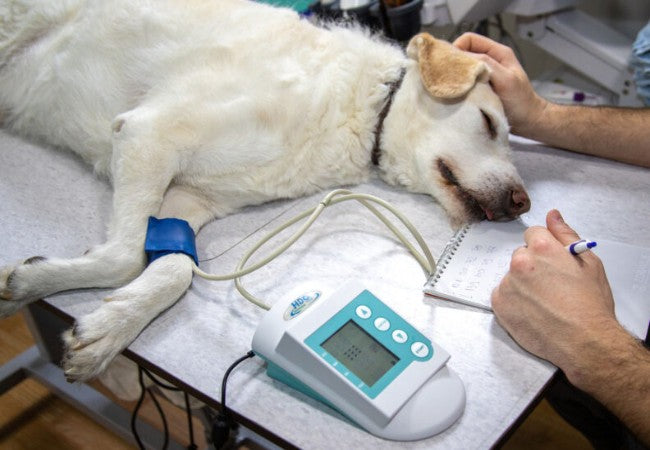Veterinary Guide to Canine Left Atrial Wall Tears 2025: Diagnosis, Treatment & Heart Support 🐾❤️

In this article
Veterinary Guide to Canine Left Atrial Wall Tears 2025: Diagnosis, Treatment & Heart Support 🐾❤️
By Dr. Duncan Houston BVSc
🔍 What is a Canine Atrial Wall Tear?
An atrial wall tear occurs when the wall of the heart’s atrium—typically the left atrium—rips due to excessive pressure or volume overload. Often seen in dogs with mitral valve disease, the tear may leak blood into the pericardial sac, leading to pericardial effusion and potentially life-threatening tamponade.
🏥 Causes & Risk Factors
- Mitral valve degenerative disease (MMVD): Chronic leak increases atrial pressure. A sudden tear may follow severe regurgitation.
- Chordae tendineae rupture: Abrupt structural collapse causes backflow and chamber strain.
- Trauma or neoplasia: Blunt injury or tumors like hemangiosarcoma may cause direct tearing.
- Atrial dilation: Chronic enlargement due to volume overload increases wall stress.
🐕 Breeds & Age Susceptibility
- Small to medium breeds: Poodles, Dachshunds, Cocker Spaniels, and Shetland Sheepdogs are commonly affected.
- Often dogs are older, frequently with a history of chronic heart disease.
⚠️ Clinical Signs
- Sudden collapse, weakness, fainting (syncope)
- Labored breathing, panting, distress signs
- Weak or irregular pulse, muffled heart sounds
- Rapid heartbeat, signs of shock (pale gums, weak pulses).
🔬 Diagnosis: Imaging & Lab Tests
Physical exam: Detect muffled heart sounds, weak pulse, jugular distension.
Thoracic X-ray: May reveal an enlarged, rounded cardiac silhouette suggestive of pericardial effusion.
Echocardiography: Gold standard. Detect fluid around the heart, visualize tear or clot, and assess chamber sizes.
Pericardiocentesis: Ultrasound-guided removal confirms hemopericardium.
Blood tests: CBC/chemistry to evaluate organ status, clotting, anaemia.
🩺 Emergency Treatment
1. Pericardiocentesis
Immediate removal of blood from the pericardial sac can relieve tamponade, stabilize pressure and save the dog’s life.
- Often lifesaving—but monitoring is vital because bleeding may recur.
2. Medical Stabilization
- IV fluids to maintain blood pressure (careful not to increase fluid overload).
- Oxygen where respiratory distress is present.
- Analgesics and anxiolytics to reduce cardiac workload.
3. Surgical Intervention
In appropriate candidates, emergency surgery may involve:
Repair of the tear and optionally addressing the underlying mitral valve disease via mitral valvuloplasty or valve replacement.
- Partial pericardiectomy to reduce fluid reaccumulation.
- Cardiopulmonary bypass may be needed during complex repairs.
Surgical intervention can significantly improve outcomes but carries high risk and isn't widely available.
📊 Prognosis & Survival
- Without intervention, survival is often measured in hours to days.
- Pericardiocentesis can temporarily stabilize, but recurrence is common.
- Dogs that undergo successful surgery may experience significantly prolonged survival, especially if underlying mitral valve disease is corrected.
- In a study of left atrial rupture in dogs with MMVD, median survival was ~203 days, with better outcomes in those without prior CHF.
- Long-term prognosis remains guarded; close monitoring is essential.
🏠 Home Care & Follow-up
- Strict rest for at least 4–6 weeks post-event/surgery. No strenuous activity.
- Regular check-ups every 2–4 weeks initially, with physical exams, imaging, and labs.
- Manage underlying heart disease with medications like pimobendan, ACE inhibitors, and diuretics.
- Monitor for signs of relapse: exercise intolerance, coughing, breathing issues.
- Ensure medication and fluid protocols are meticulously followed.
💡 Why 2025 Is Different
- Advanced imaging: High-resolution echo allows early detection of atrial thinning and micro-rupture.
- Valve repair surgery for MMVD (mitral valvuloplasty) is increasingly performed at select referral centers.
- Remote monitoring platforms like Ask A Vet guide stabilization and recovery.
- Emerging techniques help guide minimally invasive cardiac interventions.
🔧 Role of Ask A Vet & Wooft
- Ask A Vet: Instant access to cardiology guidance, emergency stabilization protocols, and advice on when to seek advanced imaging or surgical referral.
👨⚕️ Final Thoughts from Dr Duncan
Atrial wall tears are rare but serious emergencies. With prompt diagnosis—especially echocardiography—and early pericardiocentesis or surgery, some dogs can be stabilized and recover meaningfully. In 2025, veterinary heart care has advanced significantly, offering new hope. However, tight follow-up and heart disease management remain critical.
Trust your instincts—collapse, difficulty breathing, muffled heart sounds or sudden weakness always require immediate veterinary attention.
Visit AskAVet.com or download the Ask A Vet app for 24/7 expert vet support during cardiac emergencies.






